Annual State of NHSScotland Assets and Facilities Report for 2014
Report on the State of the Estate 2014
5.0 Performance
This section of the report reviews asset and facilities services performance across NHSScotland with the aim of gaining an insight into where opportunities lie for improving performance.
5.1 The National Asset and Facilities Performance Framework
The National Asset and Facilities Performance Framework provides an essential link between asset and facilities services performance and patient needs as defined in the NHSScotland Quality Strategy's three Quality Ambitions. Since introducing the Performance Framework in the 2011 State of the NHSScotland Estate Report further work has been undertaken to align the Framework with the outcome measures for the Quality Strategy developed by the NHSScotland Quality Measures Technical Group. The diagram below shows the relationship between the Quality Strategy and the National Asset and Facilities Services Performance Framework.
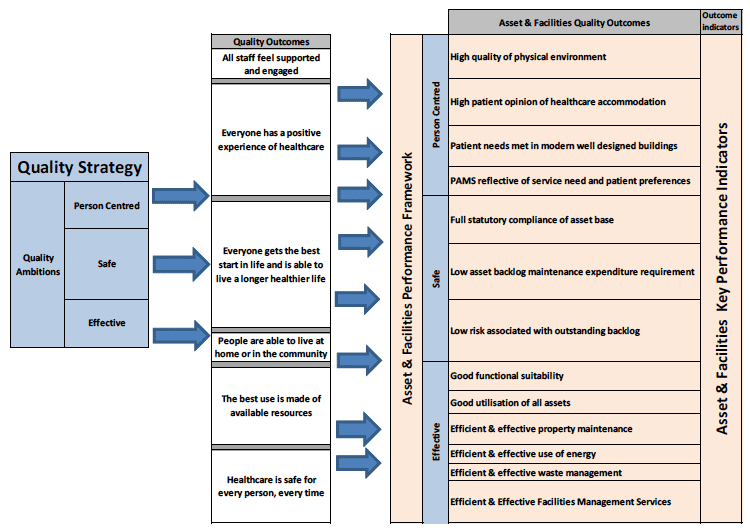
The Framework provides targets for improvement in asset and facilities services performance by 2020 and uses 23 key performance indicators to monitor year on year progress towards the achievement of these targets. It should be noted that the 2020 Performance Targets are (a) provisional and subject to review to reflect the outcome of the work on the 2020 Vision, and (b) based on the qualification that their attainment will not reduce service quality. Broadly, half of the KPIs are based on quality measures and half are based on cost measures. The National Asset and Facilities Performance Framework for 2014 is shown overleaf.
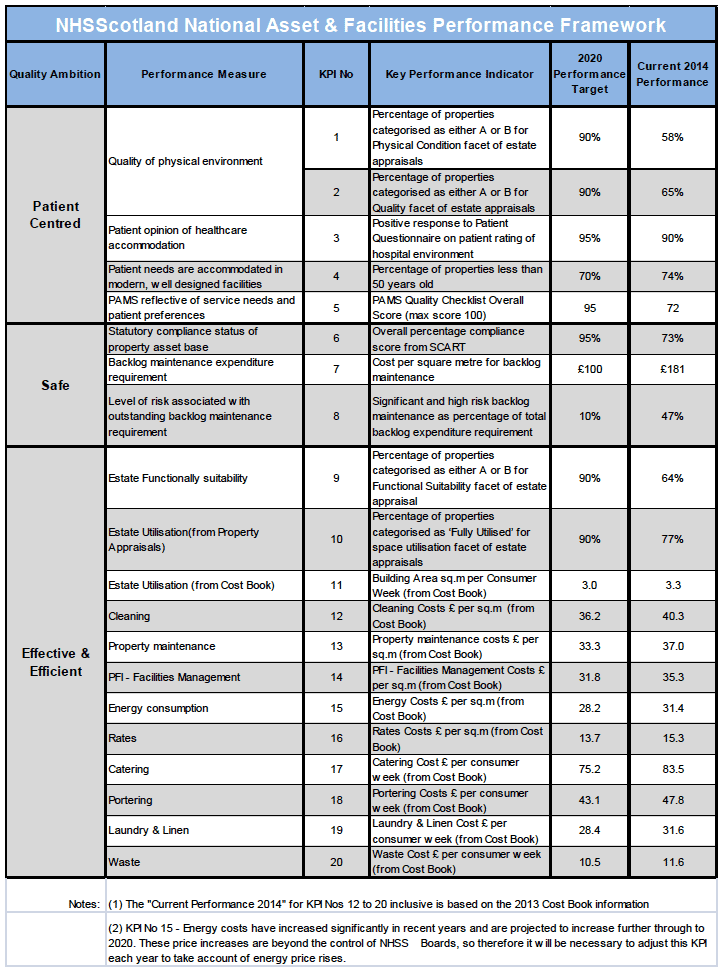
5.1.1 Change in Framework KPIs - 2013 to 2014
A key objective of this report is to monitor year on year change in asset and facilities services performance to ensure that NHSScotland is progressing towards achievement of the 2020 targets in the National Asset Performance Framework. The table below shows the performance change between 2013 and 2014.
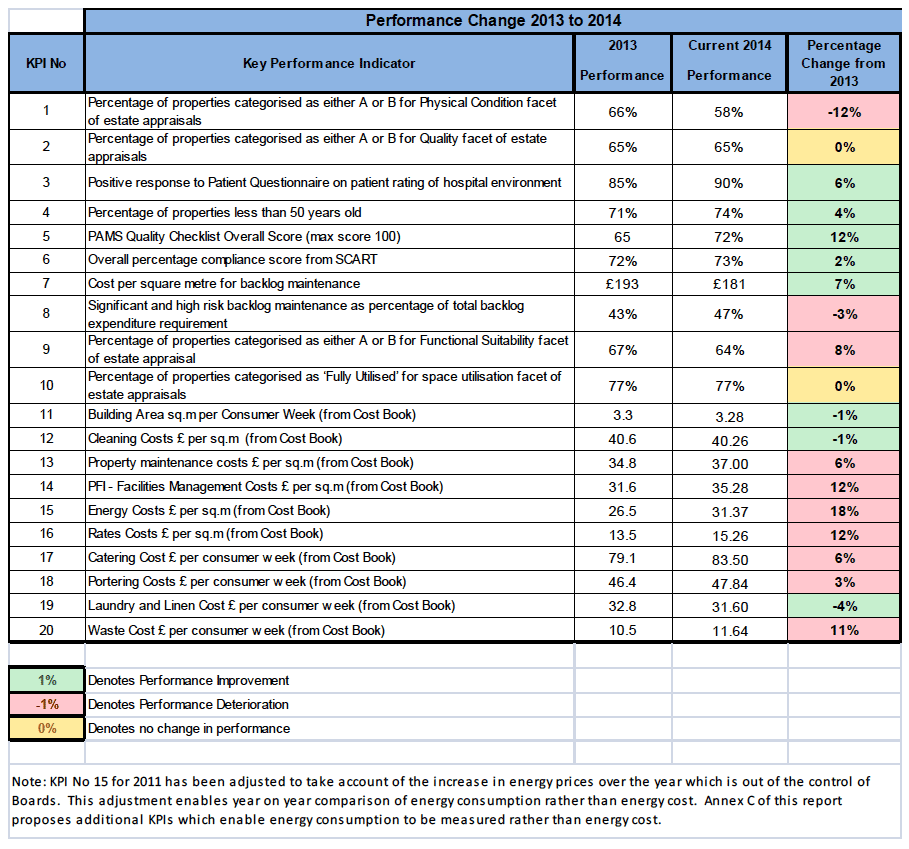
Note: figures and percentages have been rounded for ease of reporting purposes.
Percentage Change is the real percentage change since 2013 and not percentage point change.
'Percentage of properties' indicators are based on overall floor area, unless otherwise stated.
Cost based indicators are affected by external influences such as inflation, as well as performance.
Annual changes to these KPI's are further explained in the following section:
5.1.2 Changes in National Asset Performance Framework KPIs
The following provides an overview of performance change between 2011 (when the performance framework was first developed) and 2014, along with a short commentary on the changes.
| KPI Nos 1 to 10 - Derived from property appraisal information and PAMS provided by Boards (Note: 'Percentage of properties' indicators are based on floor area, unless otherwise stated). |
|
|---|---|
| Physical Condition (Percentage of estate area in Category A & B) 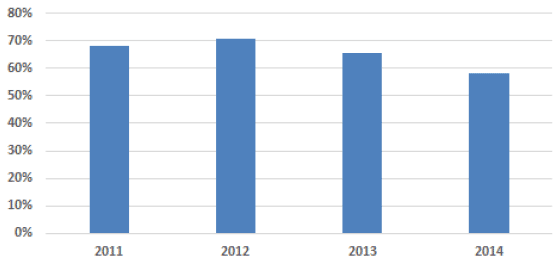 |
Physical Condition Over that last four years the reported physical condition of the estate has ranged between 58 - 68% being in satisfactory condition (category A & B). Boards advise that this variation is as a result of:
|
| Quality (Percentage of estate area in Category A & B) 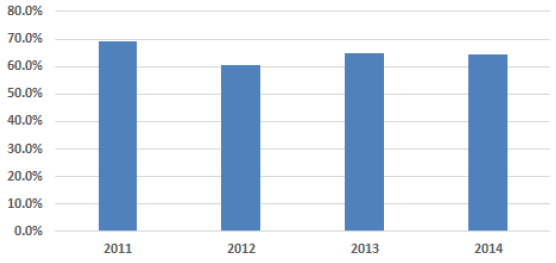 |
Quality After fluctuations in the first few years of measuring this facet of the estate, the KPI appears to have stabilised over the last two years at circa 65%. As can be expected, this facet is showing broad correlation with the physical condition facet and is thus expected to follow similar improvements in the future as investment in facilities is implemented. |
Positive Patient Rating of Hospital Environment 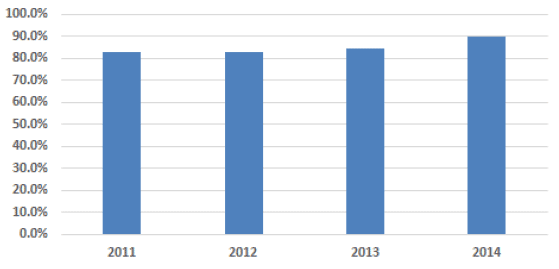 |
Patient Rating of the Hospital Environment This is the sole indicator taken from NHSScotland's patient questionnaire survey which has seen a significant 5 percentage point improvement in the patient's opinion on the hospital environment, with a positive rating now at 90%. This includes 13 out of the 15 Boards surveyed who have seen an improvement in this indicator. |
Properties less than 50 years old 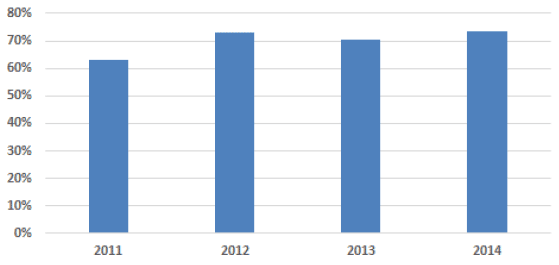 |
Properties less than 50 Years Old The proportion of properties less than 50 years old has remained fairly stable at circa 70% over the last 3 years, with further improvement expected as major new developments are completed to replace older parts of the estate. These include:
|
| PAMS Quality Checklist Overall Score (Maximum 100) 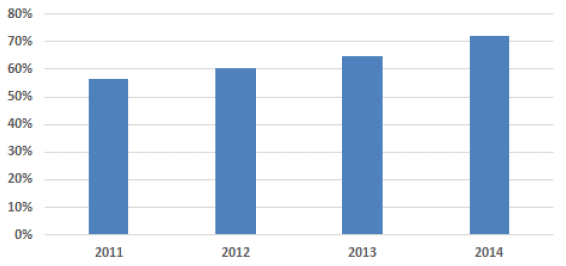 |
PAMS Quality Checklist Overall Score (max score 100) This indicator shows continued general improvement in the quality and content of NHS Boards PAMS over the last four years. This reflects a strong focus by Boards over recent years on improving the quality and consistency of their property data and the continued aim of linking property changes to clinical and service strategies. |
Overall SCART Score  |
Overall percentage compliance score from SCART SCART is a self-assessment tool that indicates general compliance with policies and procedures related to property aspects of statutory compliance. This indicator shows a continued improvement over the last 3 years. The initially assessment in 2011 concentrated on high priority areas, such as inpatient accommodation, whereas the subsequent further assessments from 2012 onwards, which covers circa 88% of NHS Boards' estate, identified a wider range of improvement needs. |
Backlog Cost per sq.m 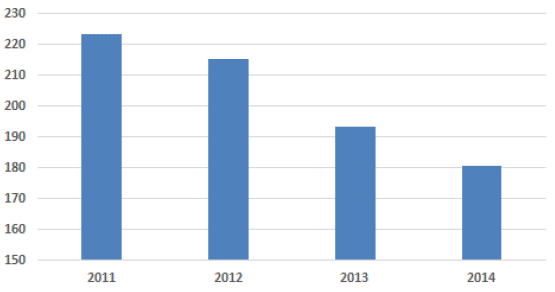 |
Backlog Maintenance Cost per sq.m. This is an important indicator for estate performance and shows a continual improvement (reduction) over the four year period. Whilst some of this is due to the substantial re-survey work commissioned by HFS, it also reflects the Boards' focus on reducing backlog through direct investment in rectification of backlog maintenance, as well as the rationalisation of redundant properties following completion of new investment projects. Further improvements in this indicator are expected as continued investment is carried out on the ageing & poor condition parts of the overall estate - see Section 5.1.4 for details of how backlog is expected to reduce further over the coming years. Since 2011 there has been a reduction of £213 million in backlog across the NHS Boards estate. |
Percentage of High and Significant Risk Backlog 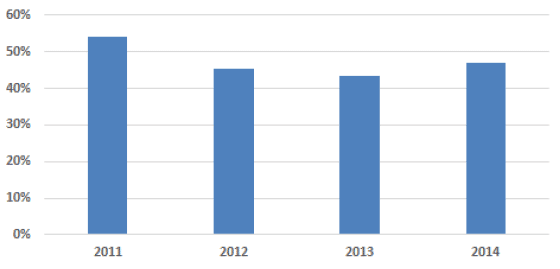 |
Proportion of Significant & High Risk Backlog Maintenance This indicator confirms that over the four year period the investment in reducing backlog described above has been focussed on the most important high and significant risk backlog maintenance items. Further details of past and future changes to significant and high risk backlog can be found in Section 5.1.4. |
| Functional Suitability (Percentage of area in Categories A & B) 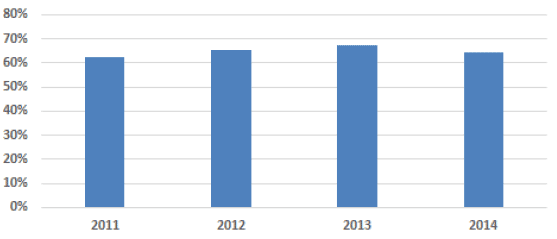 |
Functional Suitability Whilst there has been a gradual improvement in this KPI between 2011 and 2013 there was a small dip in this measure for 2014. NHS Boards advise that this is as a result of the substantial re-appraisal of this indicator over the last year. The substantial planned investment programme (as outlined above against the KPI's for physical condition and age) are expected to improve this KPI in the future. |
| Space Utilisation (percentage of area fully utilised) 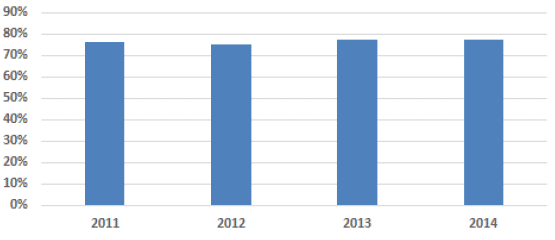 |
Fully Utilised Space The area of the estate that is regarded as fully used has remained relatively constant at between 75-77% over the last 4 years. This remains an ongoing focus for Boards as they continue to reconfigure their estate to make the most effective use possible of this complex accommodation. Boards will also need to prepare plans to fully utilise the new accommodation that will come on line over the next 5+ years. |
| KPI Nos 11 to 20 - Cost Book Derived KPIs | |
| As part of the measures to improve the quality and consistency of data, the unit of measurement for building size was changed from 100 cu.m to sq.m in the 2012 Cost Book. Therefore, comparisons can only be made for the last two years on these KPIs. | |
Building Area (sq.m) per Consumer week 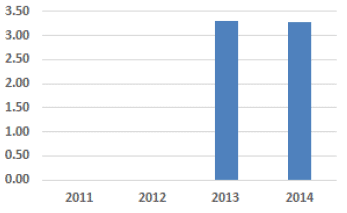 |
Space Utilisation - Building Area per Consumer Week There has been little change in this KPI over the last two years |
Cleaning Costs £ per sq.m 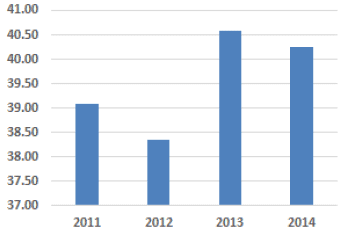 |
Cleaning Costs While this KPI has fluctuated over the four year period, overall, cleaning costs have only risen by around 3% over the period between 2011 and 2014; which is lower than CPI inflation of 10% during the same period. Boards also report that higher cleaning standards have been introduced over the last few years as a response to increased HAI standards of cleanliness. |
Property Maintenance £ Costs per sq.m 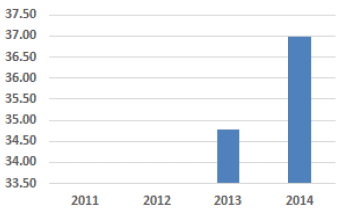 |
Property maintenance costs This KPI indicates an increase in property maintenance costs by around 6% over the last year. Boards advise that this is as a result of increased revenue spend on backlog maintenance included in the expenditure figures for property maintenance. |
PPP Service Charge Cost per Sq.m 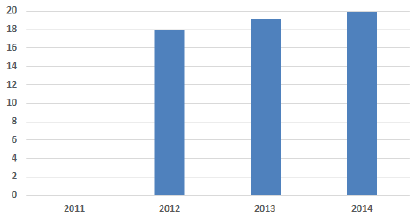 |
PPP - Service Charge Costs This KPI shows the service charge element of PPP/PFI operating costs taken from NHS Boards' audited accounts (i.e. not from Cost Book information). It doesn't include interest or recharge payment elements of a unitary charge. This shows a relatively small annual increase of around 3% over the last year, which is expected as PFI/NPD contracts are inflation linked. |
Energy Costs £ per sq.m 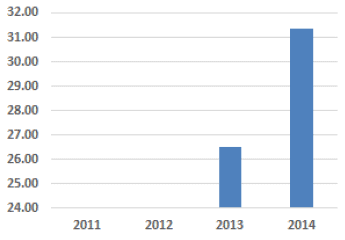 |
Energy Costs This KPI shows a significant increase of around 18% over the last year which is largely a reflection of the increases in energy costs over the same period. These energy cost increases are outside the control of NHSScotland. It should be noted that energy consumption has reduced over the period which has helped to reduce the increase in this KPI. Further information on energy performance is provided in Annex C. |
Rates Costs £ per sq.m 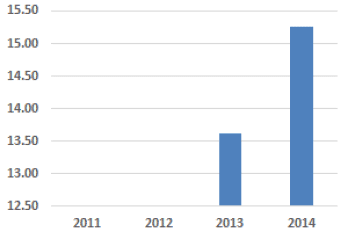 |
Rates Costs This KPI shows an increase of around 12% over the last year |
Catering costs £ per Consumer Week 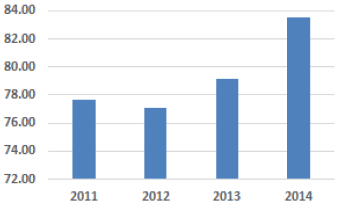 |
Catering Cost £/consumer week This KPI shows an increase in catering costs per consumer week of around 7% over the four years since 2011, which is lower than a CPI inflationary rate of 10% over the same period. A review of catering services was carried out during 2013/14 as part of the Soft FM review programme. Details of this review can be found in Annex G. |
Portering Costs £ per Consumer Week 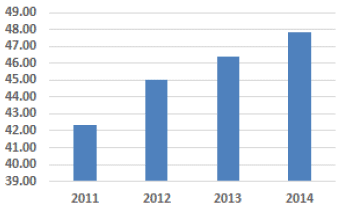 |
Portering Costs Portering Cost per consumer week has risen by around 13% since 2011. Apart from increased workforce costs, Boards explain that this service is being used to carry out additional tasks in order to reduce pressures on front-line staff. A review of Portering can also be found in Annex G, which includes the recommendation to install automated portering task tracking systems in appropriate locations. |
Laundry & Linen Costs £ per Consumer Week 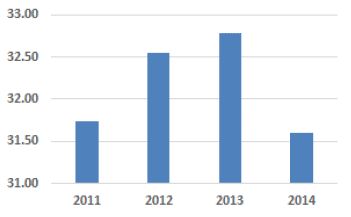 |
Laundry & Linen Costs Although there have been fluctuations year on year in this KPI it shows that over the period since 2011 Laundry and Linen costs per Consumer Week have reduced marginally. The Soft FM review of Laundry services (see Annex G) has recommended a business case to evaluate the reprovision of Laundry Production Units across NHSScotland. |
Waste Costs £ per Consumer Week 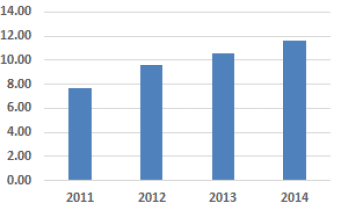 |
Waste Costs This KPI shows a substantial increase ( 52%) in Waste Costs per Consumer Week since 2011. This is as a result of increased regulation and stricter controls over the segregation and disposal of waste. A review of Waste services falls under the Facilities Shared Services Review, with opportunities for future efficiencies described in Annex F. |
As described above, the Strategic Review of Soft Facilities Management Services Programme and the Facilities Shared Services Review are both carrying out strategic reviews of FM services across NHSScotland to identify improvements and efficiencies that can be made to these services, and thus make improvements to the above performance KPI's.
It should be noted that a number of the above Cost Book derived KPIs use "consumer weeks" as the denominator in the KPI. It should be recognised that this is primarily a measure of inpatient activity and does not take account of increases in day cases, outpatients and A&E attendances. However, this does not invalidate the KPI since studies have shown that it is primarily inpatient activity which drives the numerator in each of these KPIs i.e. the two variables in each of these KPIs are highly correlated.
5.1.3 Performance variation across Boards
The Performance Framework is intended to provide a useful "national picture" of performance on a range of asset and facilities management services and the tables which follow compare each Board's performance on each of the 20 KPIs in the Framework. However, it should be recognised that comparisons between NHS Boards should be treated with some caution because:
- The size and scope of each Board's estate has historically developed over time.
- Increased spending can be a result of an improvement initiative.
- Boards may use different service delivery models to suit local circumstances i.e. number and type of duties carried out by domestic services staff may vary from site to site.
- Smaller Boards will be unable to achieve the economies of scale evident in the larger Boards.
- There are different specifications between Boards in the scope of each service.
- Allocation of costs between services and sites may not be uniform.
- Annual variances in non-recurring expenditure may distort operational KPIs i.e. expenditure on backlog incorporated within annual property maintenance costs.
- The introduction of new initiatives which improve performance take time to implement across NHSScotland.
- Clinical complexity / specialist services vary between hospitals and may drive cost differentials i.e. specialist clinical activity may result in higher clinical waste quantities and costs.
- Differences in pay and supplies costs across geographic areas i.e. some Boards may incur higher cost arising from remote and rural locations
| NHS Board | Percentage of properties categorised as either A or B for Physical Condition |
Percentage of properties categorised as either A or B for Quality |
Positive response to Patient Questionnaire on patient rating of 'hospital environment' |
Percentage of properties less than 50 years old |
PAMS Quality Checklist Overall Score (%) |
Overall percentage compliance score from SCART |
Cost per square metre for backlog maintenance |
Percentage of significant and high risk backlog maintenance |
Percentage of properties categorised as either A or B for Functional Suitability |
Percentage of properties categorised as 'Fully Utilised' for space utilisation |
|---|---|---|---|---|---|---|---|---|---|---|
| NHS Greater Glasgow & Clyde | 53% | 41% | 85 | 71% | 70% | 42% | 168 | 46% | 43% | 70% |
| NHS Lothian | 49% | 73% | 88 | 61% | 90% | 76% | 101 | 78% | 76% | 74% |
| NHS Tayside | 57% | 92% | 91 | 69% | 64% | 67% | 114 | 57% | 81% | 84% |
| NHS Grampian | 48% | 69% | 91 | 68% | 79% | 59% | 379 | 37% | 66% | 89% |
| NHS Fife | 81% | 69% | 84 | 76% | 69% | 82% | 158 | 37% | 78% | 79% |
| NHS Ayrshire & Arran | 49% | 82% | 89 | 69% | 68% | 70% | 293 | 50% | 88% | 67% |
| NHS Lanarkshire | 80% | 69% | 80 | 91% | 75% | 88% | 197 | 25% | 67% | 98% |
| Highland | 34% | 40% | 94 | 97% | 59% | 57% | 329 | 33% | 28% | 58% |
| NHS Forth Valley | 81% | 79% | 91 | 96% | 73% | 70% | 37 | 16% | 84% | 95% |
| NHS Dumfries & Galloway | 62% | 50% | 88 | 69% | 77% | 71% | 473 | 55% | 56% | 48% |
| NHS Borders | 100% | 67% | 89 | 86% | 60% | 79% | 78 | 17% | 64% | 98% |
| NWTCB - Hospital | 92% | 93% | 99 | 100% | 61% | 88% | 59 | 15% | 93% | 98% |
| Western Isles | 90% | 98% | 97 | 87% | 79% | 95% | 66 | 5% | 97% | 97% |
| The State Hospitals Board for Scotland | 100% | 100% | - | 98% | 75% | 95% | 12 | 36% | 100% | 91% |
| NHS Shetland | 57% | 68% | 91 | 53% | 80% | 65% | 161 | 82% | 72% | 98% |
| NHS Orkney | 28% | 81% | 90 | 52% | 77% | 72% | 607 | 14% | 45% | 44% |
| NHS Board Average 2014*: | 58% | 65% | 90 | 74% | 72.1% | 72% | 188 | 45% | 64% | 77% |
*: the size, scope and historical development of each Board's estate influences the 2011 starting performance base indicator and thus continues to impact on Boards' variation from the NHS Board Average
| Board | Building Area sq.m per Consumer Week (from Cost Book) |
Cleaning Costs £ per sq.m (from Cost Book) |
Property maintenance costs £ per sq.m (from Cost Book) |
PFI - Facilities Management Costs £ per sq.m (from Cost Book)** |
Energy Costs £ per sq.m (from Cost Book) |
Rates Costs £ per sq.m (from Cost Book) |
Catering Cost £ per consumer week (from Cost Book) |
Portering Costs £ per consumer week (from Cost Book) |
Laundry & Linen Cost £ per consumer week (from Cost Book) |
Waste Cost £ per consumer week (from Cost Book) |
|---|---|---|---|---|---|---|---|---|---|---|
| NHS Greater Glasgow | 3.1 | 37.3 | 28.7 | 35.2 | 33.0 | 14.3 | 73.4 | 53.8 | 26.6 | 11.9 |
| NHS Lothian | 3.3 | 39.8 | 32.8 | 61.3 | 32.9 | 15.0 | 89.3 | 47.1 | 25.5 | 8.2 |
| NHS Tayside | 4.6 | 32.4 | 33.2 | 0.0 | 23.4 | 13.0 | 77.4 | 58.3 | 39.1 | 10.7 |
| NHS Grampian | 3.4 | 57.1 | 34.6 | 0.0 | 42.5 | 16.0 | 82.0 | 58.3 | 30.6 | 13.2 |
| NHS Fife | 4.4 | 32.9 | 20.8 | 82.1 | 17.2 | 12.5 | 81.6 | 46.4 | 27.9 | 11.4 |
| NHS Ayrshire & Arran | 3.0 | 40.0 | 49.2 | 17.4 | 24.9 | 11.6 | 84.4 | 56.3 | 40.1 | 10.4 |
| NHS Lanarkshire | 2.0 | 43.7 | 88.4 | 117.4 | 25.0 | 18.4 | 88.3 | 30.4 | 41.1 | 15.3 |
| NHS Highland | 3.3 | 41.0 | 37.2 | 15.3 | 49.0 | 18.1 | 100.6 | 39.0 | 27.8 | 10.6 |
| NHS Forth Valley | 3.0 | 44.0 | 41.8 | 21.5 | 29.5 | 22.7 | 87.0 | 29.1 | 36.8 | 10.3 |
| NHS Dumfries & Galloway | 3.2 | 58.5 | 48.2 | 17.6 | 30.1 | 14.7 | 104.1 | 26.5 | 41.5 | 15.8 |
| NHS Borders | 3.1 | 44.4 | 39.9 | 0.0 | 28.0 | 15.8 | 75.6 | 28.0 | 25.8 | 10.3 |
| Golden Jubilee | 6.3 | 23.2 | 53.0 | 0.0 | 50.0 | 27.1 | 97.7 | 55.3 | 56.6 | 39.0 |
| State Hospital | 3.3 | 61.2 | 34.5 | 0.0 | 38.2 | 23.6 | 104.6 | 16.5 | 7.5 | 5.0 |
| NHS Western Isles | 3.5 | 41.1 | 40.4 | 0.0 | 50.5 | 23.9 | 121.1 | 32.3 | 43.2 | 19.1 |
| NHS Shetland | 3.6 | 75.1 | 144.1 | 0.0 | 52.9 | 19.8 | 302.2 | 123.1 | 82.5 | 7.7 |
| NHS Orkney | 2.9 | 61.3 | 63.8 | 0.0 | 50.9 | 25.2 | 107.3 | 54.7 | 101.1 | 13.2 |
| NHS Scotland 2013 Cost Book Average* | 3.28 | 40.26 | 37.00 | 35.28 | 31.37 | 15.26 | 83.50 | 47.84 | 31.60 | 11.64 |
*: Comparisons between NHS Boards should be treated with some caution for the reasons outlined at the beginning of this section.
** - This KPI uses the floor area of each Board's estate hence higher costs are more reflective of the proportion of a Board's PPP estate than its performance.
5.1.4 Projected reduction in backlog maintenance expenditure requirement
In 2011, NHS Boards estimated that the then backlog maintenance expenditure requirement of £1,010 million would reduce significantly over the next 5 year period as a result of their plans for:
- Direct expenditure on reducing high and significant backlog.
- Rationalisation and disposal of older properties thereby avoiding the need for expenditure on backlog.
- Replacement and refurbishment of existing buildings with backlog.
The following table provides an analysis of the reduction to the backlog maintenance expenditure requirement originally reported in the 2011 SAFR:
| SAFR Reporting Year | Change to backlog originally reported in 2011 SAFR (£m) |
|---|---|
| 2011 | 1,010 |
| 2012 | 911 |
| 2013 | 803 |
| 2014 | 702 |
The table shows that NHSScotland has been able to successfully reduce the backlog maintenance expenditure requirement by £308m, to a total of £702m by 2014. This is generally in line with previous projections to reduce this backlog to circa £500m by 2017.
However, as shown earlier in this report, the total backlog expenditure requirement reported by Boards in 2014 is £797 million. This figure takes account of additional newly identified backlog over the same period, which on average is adding a further 4% per annum onto the net Backlog reported in SAFR. Since 2011, this has resulted in an additional £95m of backlog maintenance expenditure requirement being reported by Boards.
It should be recognised that newly identified backlog in buildings and engineering systems is an inevitable consequence of aging buildings that occurs as a result of:
- Building and engineering elements coming to the end of their operational life, which can vary significantly depending on the element - engineering components and systems can have relatively short operational lives with most requiring replacement within 20 years whereas building elements tend toward longer operational lives of up to 60 years.
- Variations in normal day to day operational usage which can result in shorter than expected operational lives of elements and in some cases unpredicted failure of systems and the need for earlier than expected replacement.
Hence, the backlog reported by Boards in any one year is a total figure which incorporates both the impact of their investment to reduce the backlog identified in previous years and any new backlog identified within the year.
The following chart uses the backlog originally reported in the 2011 SAFR to track the actual annual change in this backlog (i.e. excluding the impact of newly reported backlog) up to 2013/14, and then plots future expectations to meet the 2016/17 projection reported in last year's SAFR:
Past and Projected Backlog Maintenance Expenditure Requirement*
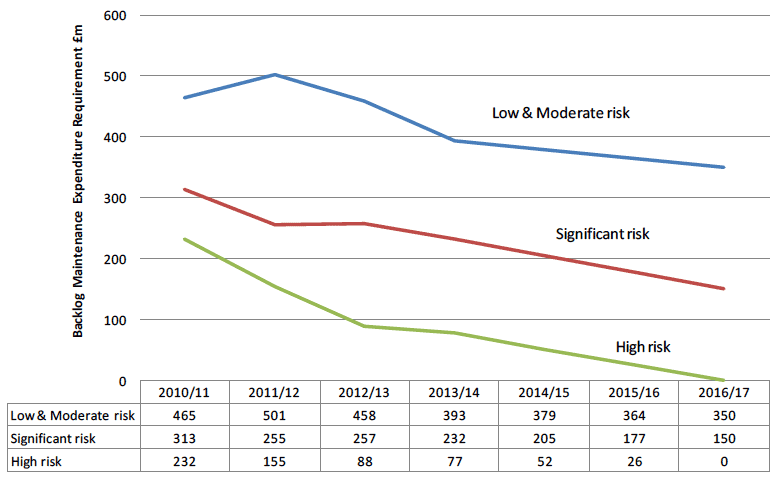
* excluding newly reported backlog
The chart shows that the greatest reduction in backlog maintenance that occurs between 2010/11 and 2013/14 relates to high and significant risk items, which confirms that as the overall backlog is reducing Boards are continuing to address high and significant risk backlog. This will remain a key focus for improvement in future years.
It is also recognised that in practice new build and refurbishment / upgrade schemes will inevitably also reduce low and moderate risk backlog when, for instance, this backlog is in the same building/area in which the high and significant risk backlog is present, hence, it is accepted that some reduction in low and moderate risk backlog will take place in parallel with the reductions in high and significant risk backlog and is a practical consequence of undertaking works in buildings.
The following table outlines the proposals being taken forward by NHS Boards that will further reduce total backlog maintenance. It also shows the impact of not taking forward the replacement projects by predicting the life cycle costs over the next 20 years if they were retained. This would add at least £500m to the future burden of backlog maintenance expenditure requirement if retained in their current state:
| Projected Impact on backlog | Avoided Future Life Cycle / Backlog Costs (next 20 years)4 |
|
|---|---|---|
| Currently reported total backlog: | £797m | |
| Main investment projects on new facilities replacing older properties1: | ||
| Completion of the South Glasgow Hospitals | -£12m | £300m |
| Replacement of Maternity Hospital at Aberdeen Royal Infirmary | -£5m | £15m |
| Replacement of Royal Hospital for Sick Children & DCN | -£2m | £50m |
| Replacement of Dumfries Hospital and rationalisation of existing estate | -£37m | £85m |
| Replacement of Balfour Hospital, Orkney | -£9m | £50m |
| Main investment projects redeveloping existing estate1: | ||
| Major backlog programme to existing inpatient accommodation at Aberdeen Royal Infirmary | -£15m | |
| NHS Ayrshire & Arran's 'Building for Better Care' investment programme & redevelopment of Ayrshire Central Hospital site | -£20m | |
| Redevelopment of Royal Edinburgh Hospital site | -£15m | |
| Further Estate Rationalisation2: | -£80m | |
| Direct Investment on Backlog3: | -£80m | |
| Anticipated backlog following impact of above proposals: | £522m | |
1: Based on impact of investments taken from Boards' PAMS & EAMS information.
2: Estate rationalisation taken from Board's PAMS, EAMS information, and disposal register.
3: Assumed backlog reduction is 50% of direct investment outlined in Boards' PAMS & pro-forma information.
4: Estimates taken from the Capital Planning System lifecycle model, totalling £500m but excluding future inflation.
Of the retained backlog from the above table, 24% is in non-clinical areas and a further 42% is of low to moderate risk backlog only; neither of which will materially impact on the delivery of healthcare services. Of the remaining circa £180m, (of which, a substantial proportion is the £95m of newly reported backlog), Boards have in place plans to reduce this through investment plans not included in the above list, and also to mitigate any outstanding risks through good asset & risk management practices.
In summary, whilst this analysis and projections of future backlog provides a high level indication of how backlog is likely to be reduced over the next few years, it needs to be recognised that in practice it is very difficult to accurately project changes in backlog in existing buildings, and timings for estate rationalisation can be influenced by a number of factors including operational priorities and market forces (in relation to disposals).
Future SAFR reports will continue to monitor annually how Boards are actually reducing their overall backlog as well as the risk profile of the backlog.
5.1.5 Estate Performance at Hospital Level
As part of the ongoing development of the Estate Asset Management System (EAMS) it is now possible to report on property asset KPI's such as backlog maintenance and physical condition at hospital level. Analysis of this information enables identification of hospitals with the highest backlog maintenance cost and the largest area of accommodation categorised as either C or D for the facet of physical condition. This enables comparisons to be made between these hospital level indicators and highlight the strategic plans for improvement included within the appropriate NHS Board's PAMS. The results of this analysis and the strategic plans for improvement can be found in the following two tables:
The following table lists the 10 NHSScotland hospitals with the highest total cost for backlog maintenance, which naturally focuses on larger accommodation types. The total cost associated with these properties of circa £290m accounts for 36% of the overall backlog maintenance cost for NHSScotland; with over half of this £290m attributable to significant and high risk backlog. Prioritisation of investment on these properties would make a significant contribution to reducing NHSScotland's backlog maintenance burden.
| NHS Board | Property | Total Backlog Cost | Strategic Plan (identified from the Board's PAMS) |
|---|---|---|---|
| NHS Greater Glasgow & Clyde | Inverclyde Royal Hospital | £44m | Part of general backlog maintenance & service infrastructure investment programme |
| NHS Dumfries & Galloway | Dumfries & Galloway Hospital | £37m | Planned replacement of hospital and estate rationalisation between 2015/16 - 2018/19 |
| NHS Ayrshire & Arran | Crosshouse Hospital | £36m | Phased service developments over next 5 years to 'front door services' & new Combined Assessment Unit, plus ongoing direct backlog investment |
| NHS Lanarkshire | Monklands Hospital | £34m | Prioritised backlog investment programme in place |
| NHS Tayside | Ninewells Hospital | £31m | Part of general backlog maintenance programme & longer term investment plans are being developed |
| NHS Greater Glasgow & Clyde | Royal Alexandra Hospital | £31m | Part of general backlog maintenance & service infrastructure investment programme |
| NHS Greater Glasgow & Clyde | Glasgow Royal Hospital | £22m | Part of general backlog maintenance & service infrastructure investment programme |
| NHS Lothian | Western General, Edinburgh | £21m | Masterplan for site being developed, including reprovision of Department of Neurosciences, and infrastructure investment plans |
| NHS Fife | Victoria Hospital, Kirkcaldy | £19m | Part of general backlog maintenance programme |
| NHS Lothian | Royal Edinburgh Hospital | £17m | Phased redevelopment of site from 2014 onwards |
| TOTAL BACKLOG: | £292m | ||
The following table lists the 10 NHSScotland hospitals with the largest overall area categorised as either C or D for the facet of Physical Condition. The total area of over 445,000 sq.m. represents 12% of NHSScotland's overall hospital estate.
Prioritisation of investment on these properties would, therefore, make a significant contribution towards improving the physical condition of NHSScotland's overall estate.
| 10 Hospitals with largest floor area categorised as either C or D for the facet of Physical Condition | ||||
|---|---|---|---|---|
| NHS Board | Property | KPI: Percentage in C or D | Floor Area (sq.m) in C or D | Strategic Plan (identified from the Board's PAMS) |
| NHS Grampian | Aberdeen Royal Infirmary | 65% | 80,466 | Backlog investment programme in place |
| NHS Lothian | Western General Hospital | 50% | 61,235 | Infrastructure investment planned with particular focus on steam plant, electrical distribution, fire alarm, external fabric and drainage |
| NHS Lothian | St. John's Hospital | 79% | 60,422 | Investment programme for roof and window replacement |
| NHS Greater Glasgow & Clyde | Gartnavel General Hospital | 77% | 49,701 | Part of general backlog maintenance & service infrastructure investment programme |
| NHS Lothian | Bangour Village Hospital | 14% | 40,486 | Part of NHS Lothian's disposal strategy |
| NHS Lanarkshire | Monklands Hospital | 77% | 40,190 | Prioritised backlog investment programme in place |
| NHS Dumfries & Galloway | Dumfries & Galloway Hospital | 66% | 31,540 | Planned replacement of hospital and estate rationalisation between 2015/16 - 2018/19 |
| NHS Lothian | Royal Edinburgh Hospital | 59% | 29,184 | Phased redevelopment of site from 2014 onwards |
| NHS Ayrshire & Arran | Crosshouse Hospital | 39% | 26,664 | Phased service developments over next 5 years to 'front door services' & new Combined Assessment Unit, plus ongoing direct backlog investment |
| NHS Ayrshire & Arran | Ayrshire Central Hospital | 90% | 26,653 | Planned replacement (circa 2015/16) with new integrated mental health and community hospital facility |
| TOTAL AREA: | 446,541 | |||
5.1.6 Asset Performance for Office Accommodation
The NHS Scotland Smarter Offices Programme was established in October 2013 with the aim of supporting improved utilisation of office accommodation across the NHS estate. An interim report was prepared jointly by the Scottish Futures Trust (SFT) and NHS National Services Scotland (NSS) in April 2014 and provides details of the work undertaken to deliver the Programme in the six months to March 2014 through initial engagement with Health Boards and a data collection exercise. This initial work has produced a more robust data set for offices, providing a strong platform for measuring on-going performance which can now be used for this report.
The Smarter Offices Programme, drawing on wider research undertaken by UK Government, has developed a set of performance measures covering workplace standards and benchmarks which this report has adopted as the Office Performance Framework. This Office Framework uses eleven KPIs as shown in the tables overleaf.
The Office Performance Frameworks for both Health Boards and Special Health Boards show that there is significant variation across Boards in terms of performance as measured by the eleven KPIs. The interim report on the Smarter Offices Programme recognised this variation in performance across Boards and identified significant potential for improving performance and providing savings in office accommodation costs for NHSScotland.
It is intended that the Smarter Offices programme will continue with the aim of:
- Improving performance of the current office estate
- Supporting Boards in developing offices strategy and New Ways of Working
- Promoting collaboration across the public sector on office strategies
- Development of case studies for successful office strategies
- Further development of Key Performance Indicators (KPIs) and benchmarking for office accommodation
This report will use the Office Performance Framework to monitor changes in performance over future years.
Office Accommodation Performance Framework
| Health Boards | Space sq.m(NIA) per headcount |
Space sq.m(NIA) per WTE/FTE |
Space sq.m(NIA) per Desk |
Desk to Headcount % |
Desk to WTE/FTE % |
Rent £/sq.m(NIA) |
Rates £/sq.m(NIA) |
Service Charge £/sq.m(NIA) |
Hard FM £/sq.m(NIA) | Soft FM £/sq.m(NIA) |
Energy £/sq.m(NIA) |
|---|---|---|---|---|---|---|---|---|---|---|---|
| NHS GG&C | 21.7 | 22.8 | 21.0 | 103% | 109% | 27.7 | 20.1 | - | 27.2 | 18.6 | 20.6 |
| NHS Lothian | 11.0 | 12.0 | 11.5 | 95% | 104% | 133.6 | 46.5 | 0.4 | 4.0 | 22.7 | 14.9 |
| NHS Tayside | 13.4 | 13.6 | 12.8 | 104% | 106% | 79.9 | 19.2 | - | 18.2 | 34.5 | 26.1 |
| NHS Grampian | 11.2 | 11.2 | 11.7 | 96% | 96% | 66.3 | 60.9 | 0.5 | 36.8 | 25.4 | 37.8 |
| NHS Fife | 14.2 | 15.4 | 14.0 | 102% | 110% | 8.0 | 22.5 | - | 5.6 | 5.6 | 26.4 |
| NHS Ayrshire & Arran | 13.3 | 14.3 | 11.4 | 116% | 125% | 33.2 | 20.7 | - | 7.9 | 6.0 | 18.9 |
| NHS Lanarkshire | 6.0 | 6.0 | 6.7 | 89% | 89% | 23.4 | 25.8 | - | 19.9 | 12.9 | 17.0 |
| NHS Highland | 8.1 | 8.8 | 8.2 | 98% | 107% | 122.6 | 63.3 | 2.2 | 8.2 | 6.0 | 29.8 |
| NHS Forth Valley | 21.2 | 21.2 | 18.6 | 114% | 114% | 51.9 | 25.4 | 8.0 | 21.5 | 11.6 | 24.2 |
| NHS Dumfries & Galloway | 20.3 | 20.3 | 22.7 | 89% | 89% | 14.3 | 10.0 | - | 13.5 | 11.2 | 20.1 |
| NHS Borders | 8.5 | 8.5 | 9.7 | 88% | 88% | - | 28.7 | - | 10.2 | 10.4 | 29.5 |
| NHS Western Isles | 10.3 | 10.3 | 10.2 | 102% | 102% | 61.8 | 72.2 | - | 18.6 | 76.3 | 26.6 |
| NHS Shetland | 12.9 | 12.9 | 11.4 | 113% | 113% | 25.0 | 18.1 | - | - | 44.2 | 23.6 |
| NHS Orkney | 8.7 | 8.7 | 8.7 | 100% | 100% | 156.3 | 63.0 | - | 3.3 | 23.5 | 42.7 |
| NWTC/Golden Jubilee | 10.4 | 10.4 | 10.4 | 100% | 100% | - | 23.3 | - | 27.9 | 22.0 | 30.5 |
| The State Hospitals Board for Scotland | 42.9 | 46.1 | 45.2 | 95% | 102% | - | 8.3 | - | 13.1 | 18.6 | 32.7 |
| Average | 14.2 | 14.7 | 14.2 | 100% | 104% | 45.9 | 26.8 | 0.7 | 17.6 | 17.0 | 23.1 |
Office Accommodation Performance Framework
| Special Health Boards | Space sq.m(NIA) per headcount |
Space sq.m(NIA) per WTE/FTE |
Space sq.m(NIA) per Desk |
Desk to Headcount % |
Desk to WTE/FTE % |
Rent £/sq.m(NIA) |
Rates £/sq.m(NIA) |
Service Charge £/sq.m(NIA) |
Hard FM £/sq.m(NIA) | Soft FM £/sq.m(NIA) | Energy £/sq.m(NIA) |
|---|---|---|---|---|---|---|---|---|---|---|---|
| NHS National Services Scotland | 10.8 | 11.7 | 10.5 | 103% | 111% | 222.16 | 75.52 | 17.56 | 17.76 | 27.43 | 27.70 |
| NHS Education for Scotland | 8.8 | 11.0 | 9.7 | 91% | 113% | 210.83 | 85.60 | 74.70 | - | 8.36 | 15.54 |
| Healthcare Improvement Scotland | 11.7 | 12.8 | 10.7 | 109% | 119% | 195.99 | 85.89 | 44.07 | 17.39 | 41.16 | 19.70 |
| NHS Health Scotland | 9.1 | 10.0 | 12.4 | 74% | 81% | 278.48 | 90.56 | 0.00 | 20.29 | 31.96 | 35.30 |
| Scottish Ambulance Service | 11.2 | 13.8 | 12.8 | 88% | 108% | 99.42 | 53.73 | 3.20 | 14.50 | 43.02 | 22.74 |
| NHS 24 | 6.4 | 9.6 | 9.7 | 66% | 99% | 143.51 | 50.18 | 21.76 | 29.16 | 28.69 | 46.80 |
| Average for SHBs | 9.2 | 11.2 | 10.5 | 88% | 107% | 198.86 | 72.03 | 26.12 | 17.46 | 27.10 | 29.42 |
5.2 Property and Asset Management Strategies (PAMS)
The Performance Framework includes an overall score for PAMS quality (KPI No 5). This results from a detailed review of each Board's PAMS. It is important that Boards are able to describe, in a consistent way, how well the totality of their existing property and assets is performing against ongoing policy objectives both now and in the longer term. A Property and Asset Management Strategy (PAMS) is the key strategic document for demonstrating how each NHS Board is performing in meeting this requirement.
The Scottish Government's "Policy for Property and Asset Management in NHSScotland" requires all NHSScotland bodies to have a Property and Asset Management Strategy which is reviewed and approved annually by its Board. Health Facilities Scotland has provided comprehensive guidance and training to support Boards in developing their PAMS.
One of the key aims for a PAMS is that as it is implemented it will fuel continuous improvement in the condition and performance of the asset base in supporting the delivery of healthcare services. The State of NHSScotland's Assets and Facilities Report provides an opportunity to review and compare each Board's PAMS.
5.2.1 Review of PAMS submitted in 2014
The PAMS that were submitted in March 2014 show that the main focus over the next few years is the delivery of NHSScotland's substantial asset investment programme and the rationalisation of the estate to reduce backlog and improve the utilisation of existing property assets.
A review of the quality and comprehensiveness of each submitted PAMS was carried out using the PAMS checklist introduced in the 2011 State of the Estate Report. Generally, the review has identified that Boards are increasingly able to link their PAMS to their service strategies; which is essential if the investment programme in assets is to achieve the expected health and care benefits, and deliver the Scottish Government's vision for the future. It has also demonstrated a year on year improvement in the quality and comprehensiveness of the PAMS submitted by Boards, as shown in the chart that follows.
PAMS Quality Checklist Overall Score (%)
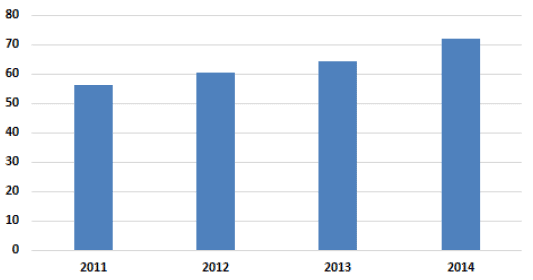
The Scottish Government and Health Facilities Scotland have recently provided extensive feedback to Boards on their 2014 PAMS through individual Board reports and interviews. This feedback was aimed at supporting Boards to further improve their PAMS for next year.
The 2014 PAMS Quality Checklist Score for each of the Boards is shown in the chart overleaf.
PAMS Quality Assessment Summary Score Sheet 2014
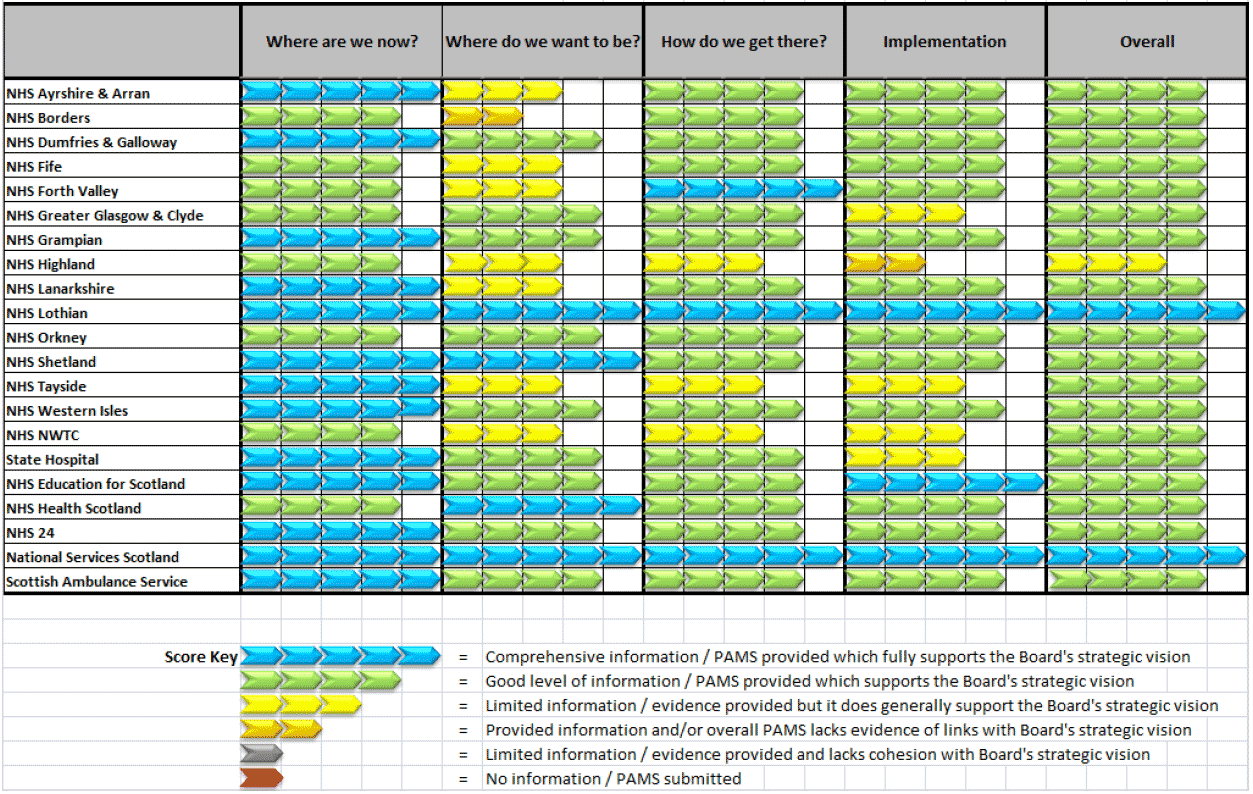
Note: Healthcare Improvement Scotland are not shown in the above table as their position was unchanged in relation to PAMS in 2014
Contact
Email: Gillian McCallum
There is a problem
Thanks for your feedback